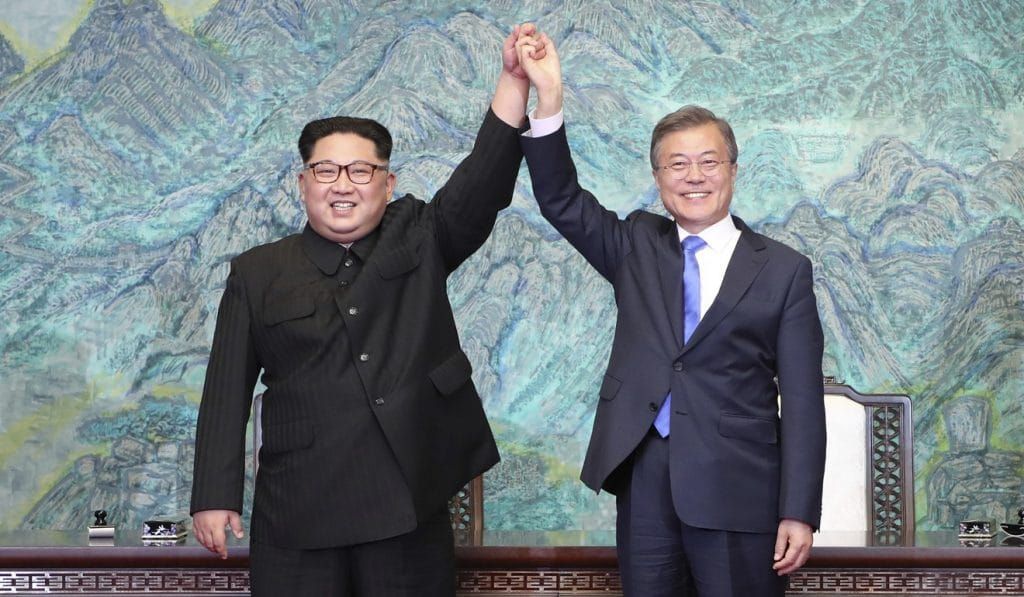Kim Jong Un is still alive. What about peace with North Korea?
By Catherine Killough | May 5, 2020
 Kim Jong Un and Moon Jae-in holding hands after signing the Panmunjom Declaration for Peace, Prosperity, and Reunification of the Korean Peninsula in April 2018. Photo credit: Cheongwadae/Blue House
Kim Jong Un and Moon Jae-in holding hands after signing the Panmunjom Declaration for Peace, Prosperity, and Reunification of the Korean Peninsula in April 2018. Photo credit: Cheongwadae/Blue House
The second anniversary of the 2018 Inter-Korean Summit has just passed. Marking the moment, South Korean President Moon Jae-in lamented, “We have been made keenly aware once again that peace will not come overnight.” Images of the two Korean leaders walking hand-in-hand to cross the demarcation line seem a distant, if not surreal memory in a world now overtaken by a global pandemic and sensational false rumors about Kim Jong Un’s health. Nevertheless, another significant milestone—the 70th anniversary of the Korean War—is fast approaching, and the prospects for peace still tug at the hearts of many.
Calls for the United States and North Korea to “make peace” tend to ring hollow in Washington. Peace is a nice sentiment until it is raised as a viable policy option, at which point it becomes a radical concept, cast as a form of appeasement or a slippery slope toward greater danger. Yet Korea peace activism remains active, not only in South Korea where the movement finds its roots, but also in the United States among a growing constituency of progressive Korean Americans and cross-movement allies. Campaigns like the recently formed Korea Peace Now! stand in a long history of women challenging militarism and war on the Korean Peninsula, and their mission to end the Korean War with a peace agreement is shared by several diasporic Korean groups today. Though their views may seem at odds with American foreign policy consensus, they offer a critical perspective for policymakers seeking a solution to the perennial US–North Korea problem.
A long-deferred peace. It should go without saying, but Korea peace activism exists in large part to draw attention to the fact that Korea is not at peace. That the Korean War never formally ended is not a mere technicality, but the source of an intractable impasse that has allowed antagonism and paranoia to fester since 1950. Although open conflict ceased in 1953 with the signing of an armistice, there has been minimal effort to “facilitate the attainment of a peaceful settlement” by the concerned governments. To make matters more complicated, South Korea was not a signatory to the armistice, and the United States and North Korea have accused one another of violating the agreement multiple times.
In this arrested and confused state of war, the Korean Peninsula is often called a tinderbox. This is no exaggeration; there have been one too many close calls for comfort, and the risks of miscalculation, as well as the stakes for renewed conflict, keep growing. In the “fire and fury” mayhem of 2017, the Congressional Research Service’s estimate of “300,000 dead in the first days of fighting” reverberated through cable news networks, think tank panels, and editorials. Most analysts would agree that seven decades of US policy to contain and constrain the North have failed to bring meaningful security to the region. Worse yet, the cumulative effect of sanctions and political isolation has left both sides with ever-diminishing prospects for reconciliation.
After 70 years, this is all made to seem normal. Perversely, even, maintaining the status quo is likened to keeping the peace. But this so-called peace includes a dividing line that separates hundreds of thousands of families; sweeping and punishing sanctions that exacerbate harm to an already struggling people; the expanding militarization of the Asia Pacific; and a costly arms race that could trigger nuclear war at a moment’s notice. For those who find the status quo unacceptable, peace activism becomes one mode of transformation—to heal, reconnect, and humanize a problem that has become fodder for pundits and wargame enthusiasts.
But skepticism abounds. Most people find it inconceivable to extend an olive branch to Pyongyang. The argument largely follows that making peace with North Korea is tantamount to legitimating its status as a nuclear power and turning a blind eye to human rights violations. This false equivalence has branded many a peace activist an apologist. Even President Moon Jae-in, who oversaw an $8.6 billion increase in South Korea’s defense spending, is habitually red-baited for his modest efforts to engage North Korean leader Kim Jong Un.
Most peace advocates hew closely to the Sunshine Policy theory of change that was popularized by former South Korean President Kim Dae-jung. They contend that a conciliatory approach is far more conducive to advancing human rights and denuclearization efforts than that of maximum pressure or regime change. Making peace with North Korea is not simply the endpoint, but a process by which resolving present-day crises is informed by a history of unresolved conflict and trauma. In practice, this has meant prioritizing a formal end to the Korean War with a peace agreement. Recalling this history is not intended to distract from today’s most pressing issues, but to fundamentally understand why those issues are so difficult in the first place.
Scholars can debate the different approaches endlessly, but policymakers in Washington too often and abruptly dismiss the pro-peace perspective. This is unfortunate, not least because it denies the voices of thousands of Korean Americans who have a personal stake in seeing US–North Korea relations improve in their lifetimes, but also because it limits the scope of creativity and the terms for engagement that are crucial to reducing tensions and closing gaps in understanding. One need only look to the missed opportunities of the last two years for reference.
In 2018, South Korea proposed that the United States sign a peace declaration—a political, non-binding statement—to move nuclear negotiations forward. The Trump administration had initially demanded that North Korea submit a full inventory of its nuclear arsenal, but when talks came to an standstill, South Korea urged the United States to accept an offer in which North Korea would “permanently dismantle” its nuclear facilities at Yongbyon for “corresponding measures, such as the end-of-war declaration.”
Critics were quick to oppose the proposal, fearing that it would prematurely lead to a peace treaty and dissolve the US–South Korean alliance. Others challenged the deal on reciprocity, arguing that a peace declaration would be too high a concession for Yongbyon. Alternatively, experts like Siegfried Hecker, the former director of the Los Alamos National Laboratory who has personally toured some of North Korea’s nuclear facilities, argued that closing Yongbyon would have constituted “a major positive signal that they are serious” about denuclearization as it would have placed a cap on North Korea’s plutonium and tritium stockpile. That would have constrained North Korea’s ability to develop nuclear warheads that could fit on intercontinental ballistic missiles, and thus significantly minimize the threat to the United States.
Looking back now, one might conclude that the Trump administration missed a major opportunity. It is just one example of many in the history of US–North Korea diplomacy that demonstrates how withholding even a symbolic gesture of peace can foreclose real opportunities to advance relations and broker a deal that would tangibly roll back a nuclear program that so vexes policymakers.
Since the collapse of the Hanoi Summit, Koreans around the world have expressed their dismay at the souring of US–North Korea relations. It is not easy to capture that pain, but turning it into action is one way that people have managed to retain hope. Peace activists have helped to keep the best vision for Korea’s future in the realm of possibility. When critically engaged, they show that it is possible to hold the idealism of peace with the complexity of its pursuit. In fact, there is no other way forward.
Together, we make the world safer.
The Bulletin elevates expert voices above the noise. But as an independent nonprofit organization, our operations depend on the support of readers like you. Help us continue to deliver quality journalism that holds leaders accountable. Your support of our work at any level is important. In return, we promise our coverage will be understandable, influential, vigilant, solution-oriented, and fair-minded. Together we can make a difference.
Keywords: Kim Jong-un, Korean War, North Korea, Yongbyon
Topics: Nuclear Risk















